

How To Date A Planet. Radiometric Dating Does Work! Radiometric dating of rocks and minerals using naturally occurring, long-lived radioactive isotopes is troublesome for young-earth creationists because the techniques have provided overwhelming evidence of the antiquity of the earth and life.
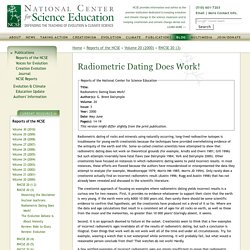
Some so-called creation scientists have attempted to show that radiometric dating does not work on theoretical grounds (for example, Arndts and Overn 1981; Gill 1996) but such attempts invariably have fatal flaws (see Dalrymple 1984; York and Dalrymple 2000). Other creationists have focused on instances in which radiometric dating seems to yield incorrect results. In most instances, these efforts are flawed because the authors have misunderstood or misrepresented the data they attempt to analyze (for example, Woodmorappe 1979; Morris HM 1985; Morris JD 1994).
Only rarely does a creationist actually find an incorrect radiometric result (Austin 1996; Rugg and Austin 1998) that has not already been revealed and discussed in the scientific literature. Views of the national parks. Big Idea 2: Earth is 4.6 Billion Years Old. How Science Figured Out the Age of Earth. Editor’s note: The following is the introduction to a special e-publication called Determining the Age of the Earth (click the link to see a table of contents).
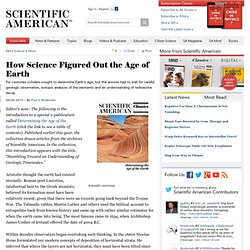
Published earlier this year, the collection draws articles from the archives of Scientific American. In the collection, this introduction appears with the title, “Stumbling Toward an Understanding of Geologic Timescales.” Aristotle thought the earth had existed eternally. Roman poet Lucretius, intellectual heir to the Greek atomists, believed its formation must have been relatively recent, given that there were no records going back beyond the Trojan War.
The Talmudic rabbis, Martin Luther and others used the biblical account to extrapolate back from known history and came up with rather similar estimates for when the earth came into being. Within decades observation began overtaking such thinking. USGS Geology in the Parks. How Do We Know the Earth Is 4.6 Billion Years Old? DETERMINING AGE OF ROCKS AND FOSSILS. THE AGE of fossils intrigues almost everyone.
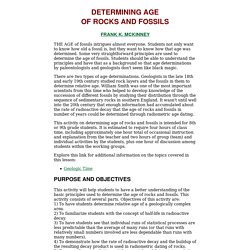
Students not only want to know how old a fossil is, but they want to know how that age was determined. Some very straightforward principles are used to determine the age of fossils. Students should be able to understand the principles and have that as a background so that age determinations by paleontologists and geologists don't seem like black magic. There are two types of age determinations. Geologists in the late 18th and early 19th century studied rock layers and the fossils in them to determine relative age.
This activity on determining age of rocks and fossils is intended for 8th or 9th grade students. Explore this link for additional information on the topics covered in this lesson: Geologic Time This activity will help students to have a better understanding of the basic principles used to determine the age of rocks and fossils. Return to top U-235 is found in most igneous rocks. A new two-minute interval begins. Geologic Time: Age of the Earth. So far scientists have not found a way to determine the exact age of the Earth directly from Earth rocks because Earth's oldest rocks have been recycled and destroyed by the process of plate tectonics.
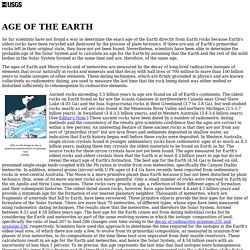
If there are any of Earth's primordial rocks left in their original state, they have not yet been found. Nevertheless, scientists have been able to determine the probable age of the Solar System and to calculate an age for the Earth by assuming that the Earth and the rest of the solid bodies in the Solar System formed at the same time and are, therefore, of the same age. The ages of Earth and Moon rocks and of meteorites are measured by the decay of long-lived radioactive isotopes of elements that occur naturally in rocks and minerals and that decay with half lives of 700 million to more than 100 billion years to stable isotopes of other elements.
Ancient rocks exceeding 3.5 billion years in age are found on all of Earth's continents. For additional information on this subject, see G. Evidence for the age of the Earth. How Old is the Earth: Scientific Age of the Earth. Efore analyzing the arguments advanced by creation “scientists” for a very young Earth, I here summarize briefly the evidence that has convinced scientists that the Earth is 4.5 to 4.6 billion years old.
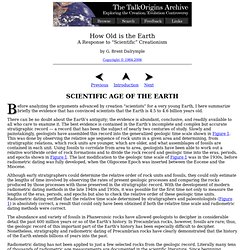
There can be no doubt about the Earth’s antiquity; the evidence is abundant, conclusive, and readily available to all who care to examine it. The best evidence is contained in the Earth’s incomplete and complex but accurate stratigraphic record — a record that has been the subject of nearly two centuries of study. Slowly and painstakingly, geologists have assembled this record into the generalized geologic time scale shown in Figure 1. This was done by observing the relative age sequence of rock units in a given area and determining, from stratigraphic relations, which rock units are younger, which are older, and what assemblages of fossils are contained in each unit. Radiometric dating has not been applied to just a few selected rocks from the geologic record.